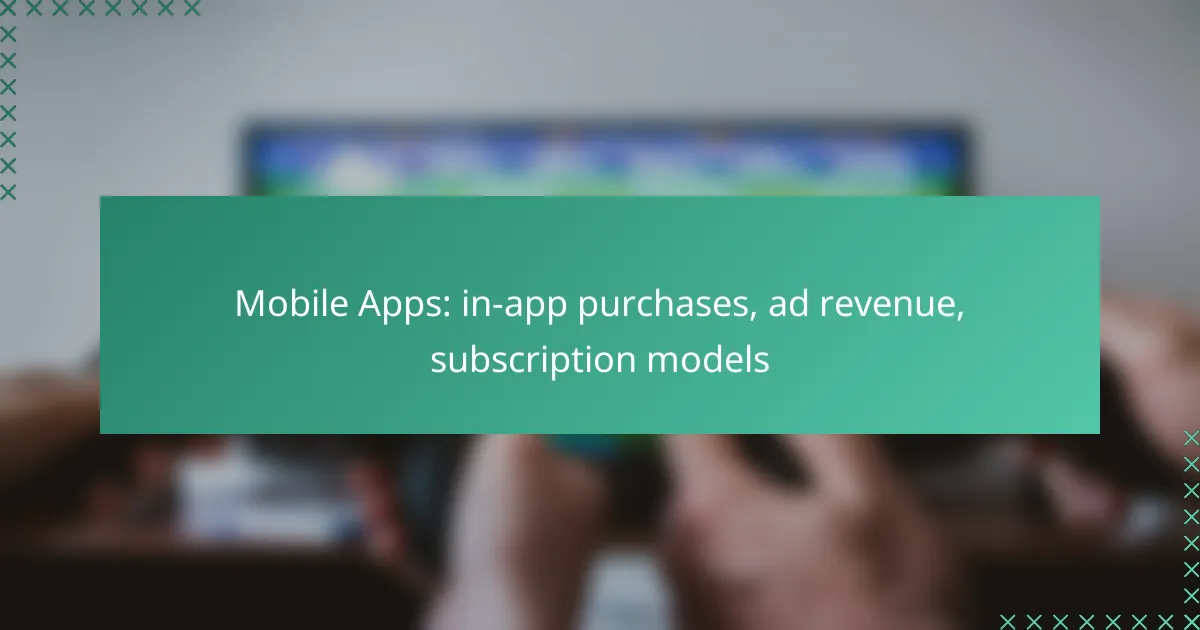Mobile apps have evolved to incorporate various monetization strategies, including in-app purchases, ad revenue, and subscription models. In-app purchases enable users to enhance their experience by buying additional features or content, while ad revenue allows developers to generate income through advertisements displayed within the app. Subscription models offer a recurring revenue stream, providing users with ongoing access to premium content or services. Together, these approaches create diverse opportunities for developers to sustain and grow their applications financially.

How do in-app purchases work in mobile apps?
In-app purchases allow users to buy additional content or features within a mobile application. This model enables developers to monetize their apps beyond the initial download, offering users enhanced experiences through various options.
Definition of in-app purchases
In-app purchases (IAP) are transactions made within a mobile app that provide users with extra features, content, or services. These purchases can be categorized into three main types: consumables, non-consumables, and subscriptions. Consumables are items that can be used once, like in-game currency, while non-consumables are permanent purchases, such as a game level or a premium feature. Subscriptions grant users access to content or services for a specified period, often with recurring charges.
Examples of popular apps with in-app purchases
Many popular mobile apps utilize in-app purchases to enhance user engagement and generate revenue. For instance, games like “Fortnite” and “Candy Crush Saga” offer consumable items and upgrades that improve gameplay. Additionally, productivity apps like “Evernote” and “Spotify” provide subscription models that unlock premium features, such as increased storage or ad-free listening experiences.
These examples illustrate how in-app purchases can cater to diverse user needs, from entertainment to productivity, making them a versatile revenue stream for app developers. Users should be mindful of their spending habits, as in-app purchases can accumulate quickly if not monitored.

What are the benefits of in-app purchases for developers?
In-app purchases provide developers with a significant opportunity to monetize their mobile applications beyond initial download fees. By offering users the option to buy additional features, content, or subscriptions, developers can create a sustainable revenue stream that adapts to user preferences.
Increased revenue potential
In-app purchases can dramatically enhance revenue potential by allowing developers to tap into a broader market. Instead of relying solely on upfront payments, developers can offer free or low-cost apps and monetize through purchases, which can lead to higher overall earnings.
For instance, many popular games and applications utilize a freemium model, where the app is free to download but offers in-app purchases for premium features or virtual goods. This approach can lead to revenue increases of several times compared to traditional pay-per-download models.
User engagement and retention
In-app purchases can significantly boost user engagement and retention by providing ongoing value and incentives for users to return to the app. When users invest in features or content, they are more likely to continue using the app to maximize their investment.
Moreover, developers can implement strategies such as limited-time offers or exclusive content to encourage users to make purchases. This not only keeps the app fresh and exciting but also fosters a sense of community among users, enhancing loyalty and long-term engagement.
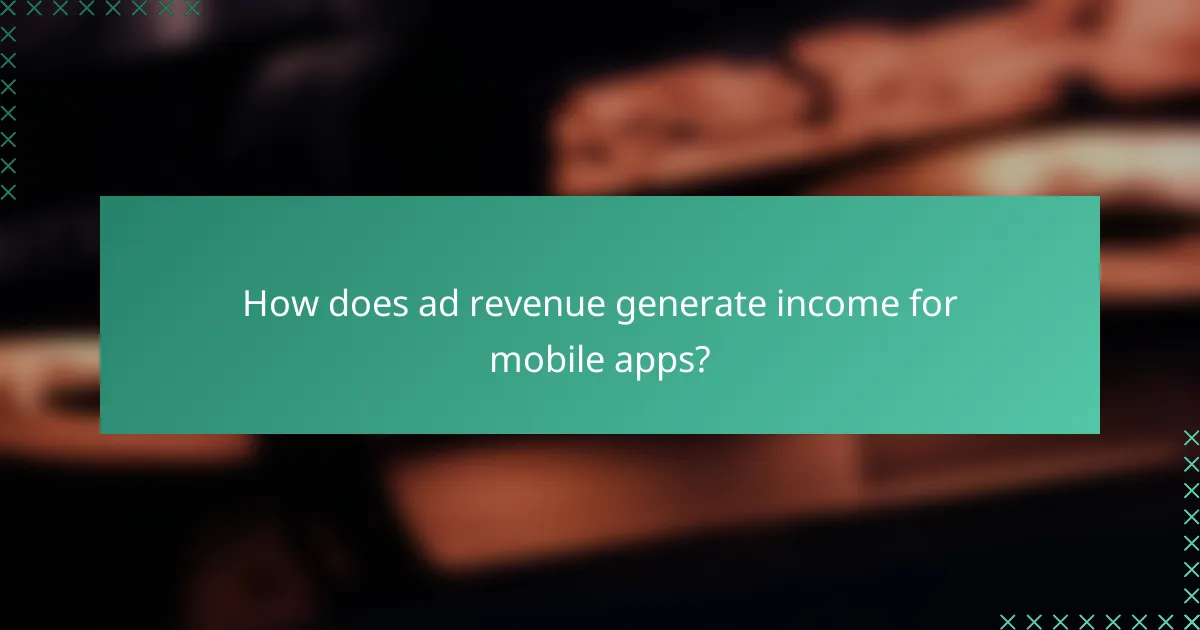
How does ad revenue generate income for mobile apps?
Ad revenue generates income for mobile apps by displaying advertisements within the app, allowing developers to earn money based on user interactions. This model can be lucrative, especially for free apps, as it provides a steady income stream without charging users directly.
Types of ad formats used in mobile apps
Mobile apps utilize various ad formats to engage users and maximize revenue. Common formats include banner ads, interstitial ads, rewarded video ads, and native ads. Each format has its own strengths; for instance, rewarded video ads incentivize users to watch ads in exchange for in-app rewards, enhancing user experience while generating income.
Banner ads are typically displayed at the top or bottom of the screen, while interstitial ads take over the entire screen during natural transition points in the app. Native ads blend seamlessly with the app’s content, making them less intrusive and often more effective.
Top ad networks for mobile apps
Several ad networks are popular among mobile app developers for monetizing their applications. Google AdMob, Facebook Audience Network, and Unity Ads are among the leading choices, each offering unique features and targeting capabilities. AdMob is known for its extensive reach and integration with Google services, while Facebook Audience Network leverages user data for precise targeting.
When selecting an ad network, consider factors such as revenue potential, ease of integration, and support for different ad formats. It’s also beneficial to test multiple networks to determine which one yields the best results for your specific app and audience.

What are the advantages of subscription models in mobile apps?
Subscription models in mobile apps provide consistent revenue and foster user loyalty. By charging users a recurring fee, developers can create a sustainable financial foundation while offering ongoing value through updates and new features.
Steady revenue stream
One of the primary advantages of subscription models is the steady revenue stream they generate. Unlike one-time purchases, subscriptions ensure that developers receive regular income, which can be crucial for maintaining and improving the app over time. This model allows for better financial planning and resource allocation.
For example, many popular apps charge monthly fees ranging from a few dollars to around ten dollars. This predictable income can help developers invest in new features, marketing, and customer support, ultimately enhancing the app’s overall quality.
Enhanced user experience
Subscription models can significantly enhance the user experience by allowing developers to focus on continuous improvement. With a reliable income, developers are more likely to invest in regular updates, new content, and user-requested features, which can lead to higher user satisfaction and retention.
Additionally, subscriptions often grant access to premium features or content that free users do not receive. This tiered access can motivate users to subscribe, knowing they will benefit from an enriched experience. For instance, streaming services frequently offer exclusive shows or ad-free experiences to their subscribers, making the subscription worthwhile.
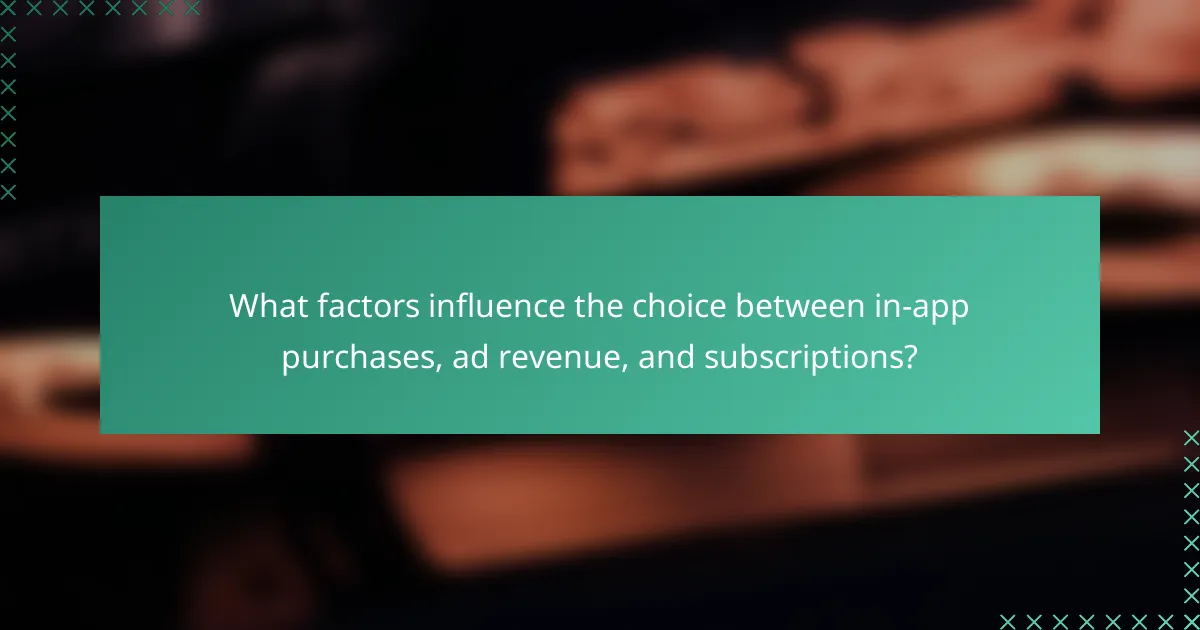
What factors influence the choice between in-app purchases, ad revenue, and subscriptions?
The choice between in-app purchases, ad revenue, and subscriptions is influenced by user preferences, app category, and market competition. Each model has distinct advantages and drawbacks that can affect revenue generation and user engagement.
Target audience preferences
Understanding your target audience is crucial when selecting a monetization strategy. For instance, younger users may prefer free apps with ad support, while older demographics might favor subscription models for premium content. Conducting surveys or analyzing user behavior can help identify which model resonates best with your audience.
Consider offering a mix of options to cater to different user segments. For example, a gaming app might provide in-app purchases for cosmetic items while also offering a subscription for an ad-free experience.
App category and competition
The app category significantly impacts the choice of monetization strategy. Games often thrive on in-app purchases, while productivity or streaming apps may find subscriptions more lucrative. Analyzing competitors in your category can provide insights into successful revenue models.
Evaluate the competitive landscape to determine what works best. If most competitors use a subscription model, consider whether you can differentiate your offering or if a different approach, like ad revenue, might attract users looking for alternatives.
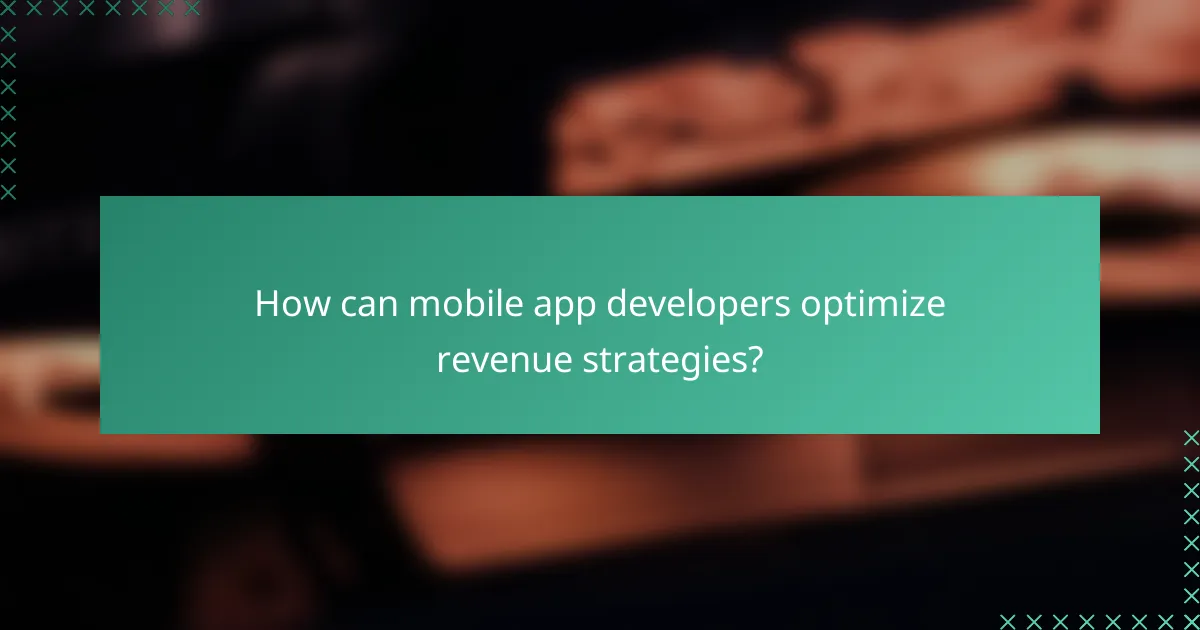
How can mobile app developers optimize revenue strategies?
Mobile app developers can optimize revenue strategies by leveraging a mix of in-app purchases, ad revenue, and subscription models. Each approach has unique advantages and can be tailored to fit the app’s target audience and market demands.
Implementing A/B testing
A/B testing allows developers to compare different versions of their app to determine which features or pricing models generate the most revenue. By systematically testing variations in in-app purchase prices, ad placements, or subscription offers, developers can identify the most effective strategies.
For example, an app might test two different subscription prices, such as $4.99 versus $9.99 per month, to see which yields higher overall revenue. It’s essential to ensure that the sample size is large enough to draw meaningful conclusions and to run tests for a sufficient duration.
Analyzing user behavior
Understanding user behavior is crucial for optimizing revenue strategies. By analyzing how users interact with the app, developers can identify patterns that inform pricing, feature development, and marketing approaches. Tools like analytics platforms can track user engagement, retention rates, and spending habits.
For instance, if data shows that users frequently abandon their carts during in-app purchases, developers might consider simplifying the checkout process or offering limited-time discounts. Regularly reviewing user feedback and behavior can lead to actionable insights that enhance revenue potential.
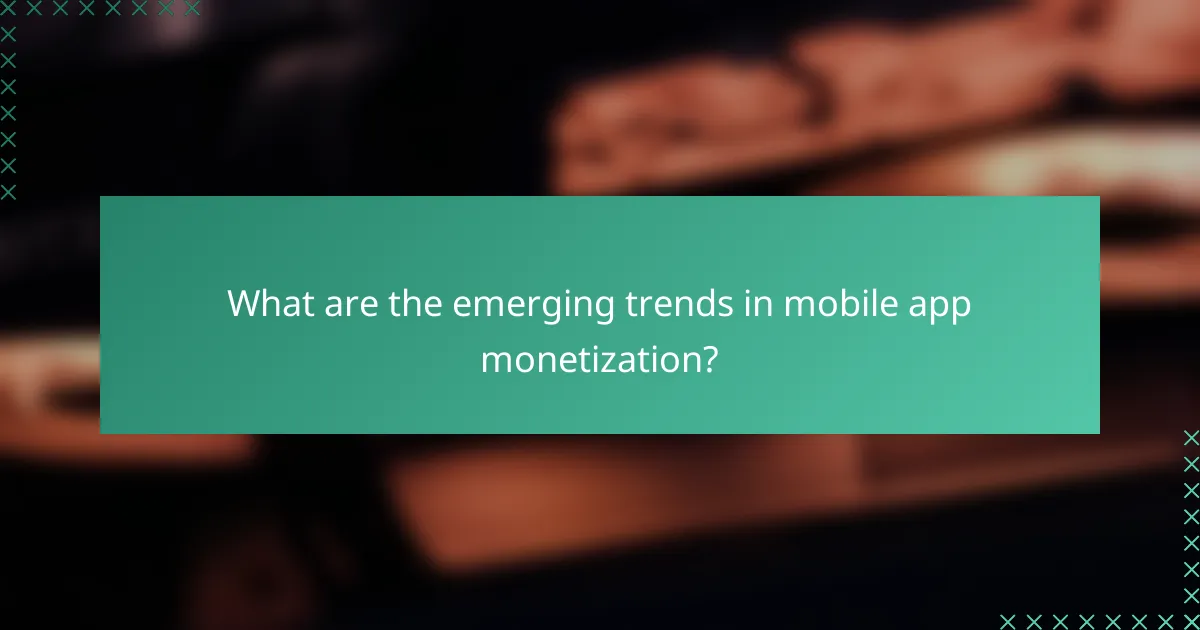
What are the emerging trends in mobile app monetization?
Emerging trends in mobile app monetization include the rise of hybrid models that combine various revenue streams, as well as the significant impact of user privacy regulations on advertising strategies. These trends are reshaping how developers approach monetization, balancing user experience with revenue generation.
Growth of hybrid monetization models
Hybrid monetization models integrate multiple revenue sources, such as in-app purchases, ad revenue, and subscription services. This approach allows developers to diversify income streams and cater to different user preferences, enhancing overall profitability.
For instance, a gaming app might offer free access with ads, while also providing optional in-app purchases for premium features. This combination can attract a broader audience, as some users may prefer to pay for an ad-free experience, while others may opt for free access with ads.
Impact of user privacy regulations
User privacy regulations, such as the General Data Protection Regulation (GDPR) in Europe and the California Consumer Privacy Act (CCPA) in the United States, are reshaping mobile app monetization strategies. These laws require developers to prioritize user consent and transparency, affecting how data is collected and used for targeted advertising.
As a result, many apps are shifting towards less invasive advertising methods or exploring alternative monetization strategies, such as subscriptions. Developers must stay informed about these regulations to avoid penalties and maintain user trust, which is crucial for long-term success.
